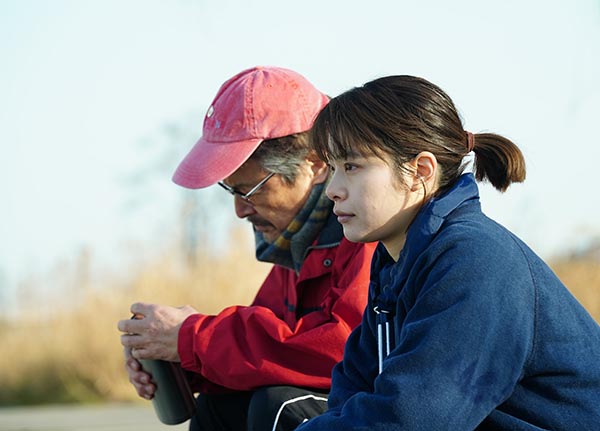Drawing inspiration from boxing classics such as Rocky, slight gem Small, Slow But Steady strikes with a subtle but forceful resonance.
The title Small, Slow But Steady takes on many meanings: it describes main protagonist Keiko (Yukino Kishii, Living in Your Sky), a woman of small stature with a steely determination; it references Keiko’s meticulous, unerring training routine and life; it even encapsulates her mentor’s (Tomokazu Miura, M/Other) declining health, worsening slowly but surely. Shô Miyake’s (And Your Bird Can Sing) layered screenplay, which he co-wrote with Masaaki Sakai (Ninkyo Gakuen) and is based on Keiko Ogasawara’s autobiographical book “Makenaide”, and considered direction not only picks out these various connotations and navigates them, but avoids mawkish sentimentality too. Rigorous and on occasion too emotionally distant for its own good, Small, Slow But Steady retains the beating heart of real life Keiko.
Keiko Ogasawara is the first hearing-impaired professional female boxer in Japan. Small, Slow But Steady loosely charts her journey, portraying Keiko’s often lonely existence, her struggles integrating into a society that doesn’t always help deaf people, and the comfort and worth she finds as a boxer at her local gym. Issues such as the COVID pandemic arise, but Miyake’s focus remains solely on Keiko throughout. He guides the viewer into her non-hearing world, the camera following Keiko as opposed to moments that aren’t audible to her.
Yûta Tsukinaga’s (#Manhole) evocative and careful cinematography elevates this further. He enhances Keiko’s isolation via framing devices such as doorways surrounded by darkness, or extracts peace from certain moments by, for example, situating Keiko alone with lapping water as a backdrop. Tsukinaga is always aware of how Keiko and her moods intertwine with her surroundings. Shooting on 16mm also allows her world to feel lived in and authentic. As Small, Slow But Steady’s plot advances and Keiko’s willpower to continue her professional boxing career are tested, Kishii gives us glimpses of the cracks forming.

Above all else, Small, Slow But Steady is a character study, one that is well-formed and respectful. Keiko’s struggles never contribute to feelings of pity, and much of that stems from Kishii’s steely performance. She manages to capture everything about Keiko, from her love to boxing, her frustrations at everyday life, and her fear at this sport she adores being taken away from her. Every so often, Kishii’s resolute face breaks, tears of sadness flowing or a smile of happiness forming. These releases are absolutely necessary, dealt out masterfully by Kishii, and give Small, Slow But Steady that much-needed vigour and emotional resonance.
At times, the rigorous, restrained execution of Small, Slow But Steady can cause some of its emotional aspects to come off as cold and difficult to connect with. Perhaps there is an inevitably to this result too, as Small, Slow But Steady charts Keiko’s journey in so much detail and with so much realism that there are bound to be moments that dip. It is vital that we see every part of Keiko’s life, from her relationships with her family to her tough training regime. Keiko’s relationship with the chairman at the gym is given the most space to breathe, the two finding calm solace together via their shared love for boxing. Small, Slow But Steady consistently finds that angle, about the serious power that community holds for people — especially during the pandemic.
Aside from being a sports drama, Small, Slow But Steady’s depiction of the deaf community is respectfully realised and told with heart. We see ignorances that seem small but have large effects on Keiko, such as a policeman cupping his hands around his mouth and shouting at her, thinking this would solve her hearing impairment. In contrast, we see Keiko with two deaf friends, their signing unsubtitled (elsewhere in the film, there are subtitles), normalising and not ‘othering’ sign language. From Keiko’s smile, we get everything we need.
Small, Slow But Steady continues with its soft tone right to its conclusion, with a narrative that rights itself towards the end but that in earlier parts feels aimless. This is a boxing drama, but it feels different to the loud inspiration of the Rocky franchise or intensity of Million Dollar Baby. There are shades of the first Rocky in a scene where Keiko trains as dawn breaks, but Small, Slow But Steady avoids noisy inspiration or underdog sensationalism, preferring a small but affecting, slow but compelling, and steady but poignant character study.
Blue Finch Film Releasing presents Small, Slow But Steady in cinemas and on Curzon Home Cinema on 30 June, 2023.

